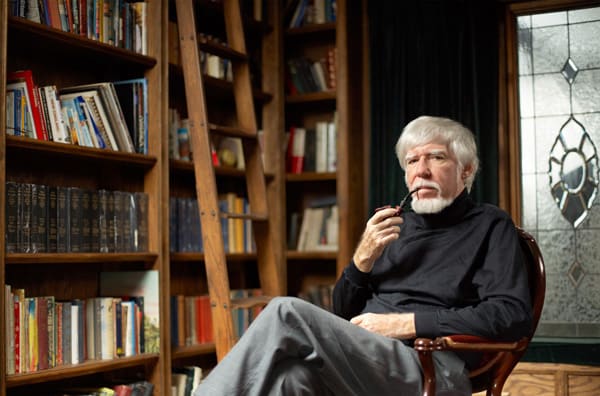Peter Thiel’s floating city in French Polynesia. Elon Musk’s self-sustaining city on Mars. Bill Gates’ smart city in Arizona. Long before a host of the biggest players in Silicon Valley set their sights on creating a new city in Solano County, California, many billionaires thought they could start their own utopia. But one man, a retired AT&T executive from Georgia, has actually been able to do it—for better or for worse.
Oliver Porter, 85, is the architect of Sandy Springs, Georgia, a city of 108,000 people outside Atlanta that set off a wave of similar new towns when it incorporated in 2005. Porter has assisted in creating nearly a dozen new cities in Georgia, and several others around the world. The legacy of that movement, which has improved services for some while icing out others, carries important lessons for those attempting to start their own private paradises today.
Porter joined the Sandy Springs planning committee in the late 1990s, more than 25 years after residents of the neighborhood started pushing for independence from the government of the surrounding Fulton County. The fight started in 1965, when Atlanta attempted to annex the wealthy, white enclave just outside the city limits and was met with resounding resistance from homeowners—in part for fear that annexation would require racial integration. (Reps for the suburb threatened to “build up a city separate from Atlanta and your Negroes and forbid any Negroes to buy, or own, or live within our limits.”)
In the years following, Sandy Springs continued to grow, leading residents to argue that it should be a city with a government of its own. By the time Porter joined the committee, the prevailing belief was that Sandy Springs residents were taxed too much by the city without receiving suitable services in return. Still, Porter says, members of the planning committee had few ideas about how they would provide those services themselves.
“I asked the question, ‘Well, how would we actually start this thing?’ And nobody had a good answer,” he told The Daily Beast. “So I went home and got out a yellow pad and wrote a piece on how to start a city.”

Oliver Porter
Muzel Chen courtesy of Oliver Porter
It wasn’t until 2004 that Republicans took control of the Georgia legislature and allowed the residents of Sandy Springs to vote on incorporation. Suddenly, after almost four decades of waiting, plans for building out the new city went into hyperdrive. The planning committee had six months to put together all the services a city would need—a police force, a fire department, city hall—and figure out how to pay for it.
“There were times when I didn’t sleep a lot,” Porter admits now. “I had gotten us out on a limb, and there were a lot of places we could fall off of it.”
Porter says the first issue was that without an authorized government, planners of the new city had no ability to pay for services. So Porter reached out to dozens of private companies to see if they would lay the groundwork for city services first, with payment later. A handful agreed, leading to the largely private infrastructure that Sandy Springs still employs, contracting everything from trash pickup to court administration from private firms.
Another issue was finding people to run the city. Without an entrenched bank of local politicians, Porter had to start a candidate school to recruit hopefuls and train them in how to run a campaign. Sandy Springs’ current mayor, former state Senator Rusty Paul, says he was personally recruited for the city council by then-Mayor Eva Galambos in order to teach other council members how to govern.
“She said, ‘You know, we don’t have anybody in Sandy Springs who’s ever been in government before,’” Paul recalled. “She said, ‘We need you to teach us how to do it—how you do motions and all that stuff.’”
There were other hiccups along the way—Paul recalled a sleepless night spent coordinating the city’s response to its first major snowfall—but by 2012, Sandy Springs was being heralded in the The New York Times as a success story. Porter wrote a book on the project, Creating the New City of Sandy Springs, and became a sort of folk hero of the “cityhood” movement, which prioritized local control above all else. (Unsurprisingly, this also made him immensely popular among small-government-touting conservatives.) To date, he has consulted on 11 other new cities in the state, including Brookhaven, Dunwoody, and Johns Creek, a privatized city in Honduras, and several cities in Japan.
Not all of these new cities went as smoothly as Sandy Springs—Porter recalled one burgeoning town council so divided it had to hire a therapist in order to govern. Perhaps the rockiest was Buckhead, a tiny suburb that proposed incorporation in 2020 due to residents’ fears about growing crime in Atlanta. Critics of the movement argued that incorporation would seal off the largely white, wealthy Buckhead from the more diverse Atlanta. The movement suffered a potentially fatal blow when the cityhood bill failed to pass the Georgia state Senate earlier this year.
Porter says his chief takeaway from the tumultuous past 30 years is that any new city requires the enthusiastic support of its residents. “Issue number one is you want to have community support. You want people who really want to have their local control,” he said. “So if you don’t have that, don’t bother.”
That could prove difficult for the architects of the Solano County project, who sowed distrust in the community by operating largely in secret for the last six years. The coalition of some of the biggest names in Silicon Valley, including Michael Moritz, Marc Andreesen, and Laurene Powell Jobs, pitted neighbor against neighbor and even sparked concerns of a threat to national security as they stealthily snatched up more than 55,000 acres of land. In May, the group sued several local landowners, accusing them of conspiring to ratchet up the price of their land. (The group had already spent some $800 million on the land grab.) Local legislators have been less than positive about the idea of a new city in the area.
But perhaps more concerning for Solano County residents is the legacy of the cityhood movement in Georgia. Virtually all of Fulton County—the county encompassing Atlanta and its former suburbs—has been incorporated into independent cities in the last decade. As a result, those living in Atlanta proper have been left with less revenue and fewer resources. In 2012, the Fulton County manager told the Times that the flood of new cities had cost the county $38 million per year in taxes that would usually have gone to the county government. The incorporation of Sandy Springs alone cost the county $90 million.
There is also the ever-present issue of segregation, evidenced by Sandy Springs’ ancestors’ threat to wall of the city from “negroes.” Advocates for cityhood argue that the movement is not racially motivated and note that at least three recently incorporated cities—South Fulton, Stonecrest, and Mableton—are majority Black. But speaking to CNN about the Buckhead bill last year, historian Matthew Lassiter pointed out how concerns about “zoning” and “preserving neighborhoods” can serve as smokescreens for racist aims.
“While the rhetoric of single-family neighborhoods is ostensibly color-blind, it has a deep foundation in the racist history of housing development,” Lassiter, a professor at the University of Michigan, told the outlet. “In our law and in our politics, the single-family housing framework defends the right of people to exclude others from living near them based on income and economic resources.”
The Solano County project would not be walling off an already wealthy, white area like Sandy Springs; Solano is the poorest county in the Bay Area, with a median household income of $87,770, and several backers of the project are vocal advocates for more affordable housing in San Francisco. But many are also staunch critics of the crime and corruption in the city—similar to the concerns raised by cityhood proponents in Georgia. When constructing a utopia, it turns out, it’s helpful to wonder: Who is it leaving out?


